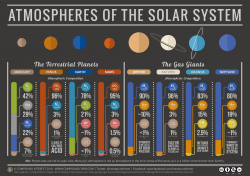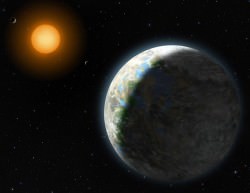We’ve found hundreds of exoplanets in the galaxy. But only a few of them have just the right combination of factors to hold life like Earth’s.
The weather in your hometown is downright uninhabitable. There’s scorching heatwaves, annual tyhpoonic deluges, and snow deep enough to bury a corn silo.
The bad news is planet Earth is the only habitable place we know of in the entire Universe. Also, are the Niburians suffering from Niburian made climate change? Only Niburian Al Gore can answer that question.
We as a species are interested in habitability for an assortment of reasons, political, financial, humanitarian and scientific. We want to understand how our own climate is changing. How we’ll live in the climate of the future and what we can do to stem the tide of what our carbon consumption causes.
There could be agendas to push for cleaner energy sources, or driving politicians towards climate change denial to maintain nefarious financial gain.
We also might need a new lilypad to jump to, assuming we can sort out the travel obstacles. The thing that interests me personally the most is, when can I see an alien?
The habitable zone, also known as the “Goldilocks Zone”, is the region around a star where the average temperature on a planet allows for liquid water with which to make porridge. It’s that liquid water that we hunt for not only for our future uses, but as an indicator of where alien life could be in the Universe.
Problems outside this range are pretty obvious. Too hot, it’s a perpetual steam bath, or it produces separate piles of hydrogen and oxygen. Then your oxygen combines with carbon to form carbon dioxide, and then hydrogen just buggers off into space.
This is what happened with Venus. If the planet’s too cold, then bodies of water are solid skating rinks. There could be pockets of liquid water deep beneath the icy surface, but overall, they’re bad places to live.
We’ve got this on Mars and the moons of Jupiter and Saturn. The habitable zone is a rough measurement. It’s a place where liquid water might exist.
Unfortunately, it’s not just a simple equation of the distance to the star versus the amount of energy output. The atmosphere of the planet matters a lot. In fact, both Venus and Mars are considered to be within the Solar System’s habitable zone.
Venusian atmosphere is so thick with carbon dioxide that it traps energy from the Sun and creates an inhospitable oven of heat that would quickboil any life faster than you can say “pass the garlic butter”.
It’s the opposite on Mars. The thin atmosphere won’t trap any heat at all, so the planet is bun-chillingly cold. Upgrade the atmospheres of either planet and you could get worlds which would be perfectly reasonable to live on. Maybe if we could bash them together and we could spill the atmosphere of one onto the other? Tell Blackbolt to ring up Franklin Richards, I have an idea!
When we look at other worlds in the Milky Way and wonder if they have life, it’s not enough to just check to see if they’re in the habitable zone. We need to know what shape their atmosphere is in.
Astronomers have actually discovered planets located in the habitable zones around other stars, but from what we can tell, they’re probably not places you’d want to live. They’re all orbiting red dwarf stars.
It doesn’t sound too bad to live in a red tinted landscape, provided it came with an Angelo Badalamenti soundtrack, red dwarf stars are extremely violent in their youth. They blast out enormous solar flares and coronal mass ejections. These would scour the surface of any planets caught orbiting them close enough for liquid water to be present.
There is some hope. After a few hundred million years of high activity, these red dwarf stars settle down and sip away at their fuel reserves of hydrogen for potentially trillions of years. If life can hold on long enough to get through the early stages, it might have a long existence ahead of it.
When you’re thinking about a new home among the stars, or trying to seek out new life in the Universe, look for planets in the habitable zone.
As we’ve seen, it’s only a rough guideline. You probably want to check out the place first and make sure it’s truly liveable before you commit to a timeshare condo around Gliese 581.
Do you think habitable planets are common in the Milky Way? Tell us what your perfect planet environment might be in the comments below.




Assuming there are no Science Fiction type life and all life is based off of carbon like ours, I think the Natural Habitable zone around stars are much narrower that previously though. Earth is closer to the inside edge of our habitable zone than the outside edge. Venus is clearly inside the habitable zone not just on the boarder. Mars is technically just inside the outside edge of the zone. It’s just too small to hold onto a thick atmosphere especially without a significant electromagnetic field to help shield the planet from the solar winds and other solar weather.
What does this mean? A lot fewer planets in our galaxy like ours. And lets not forget, our society which can possibly hold a two-way conversation with aliens has been around for a little less than a second on the galactic 24 hour clock that runs the day starting at the big bang. So we could be too late or too early to talk with any race that could possibly communicate with us.
According to this article http://www.nbcnews.com/science/8-8-billion-habitable-earth-size-planets-exist-milky-way-8C11529186 , real scientists, like Geoff Marcy think there are at least 8.8 billion earth like planets in the habitable zone, and that is just for sun like stars. If the average of all stars in the galaxy is 1 in 5 have an earthlike planet in the habitable zone, that number grows to 40 billion, at least (assuming 200 billion stars, which is probably a low estimate). Is there any reason to assume this number is too big? We have one example of one star with 1 earthlike planet in it’s habitable zone. That’s 1 for 1 so far….Suppose of those 40 billion, some will be tidally locked around red dwarfs, some will be too hot, some too cold, some too young, some too old. Suppose 1 in a million are actually habitable to carbon based life right now, that leaves 40000 habitable planets. Seems like a lot, but given the distances in between stars, they could be thinly spread out among those 200+ billion stars. At those numbers, we will be searching for needles in a big haystack. Maybe the odds are better than that, but we won’t know until we have better telescopes to actually view some of their atmospheres. Until then, it’s all a guessing game.
Yes, I suppose if Mars and Venus were to swap orbits then both would be more habitable.
The HZ concept is to be understood statistically. Any particular planet might be inhabitable because of its specific atmosphere. Those atmospheres are about to be studied with new great telescopes the coming few years, and then one can check off more habitability factors than just insolation (and orbital eccentricity and density which are revealed through transit and doppler shift observations combined) for specific exoplanets. the exoplanet adventure is just beginning!